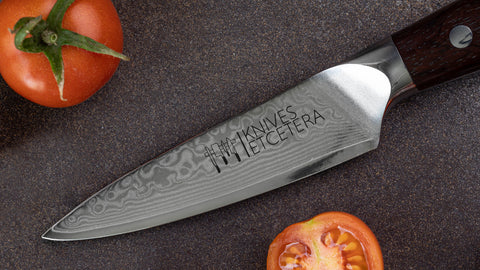When it comes to the most crucial knife features during kitchen prep, most professionals and amateurs alike will refer to the level of sharpness of the knives that they are using as their key consideration.
A sharp knife helps the user to make easy and smooth cuts while also helping with another ultra-important aspect of the kitchen cooking experience - presentation. A beautifully sliced piece of meat will not only help expose flavors but will also look much better when presented on the dinner table.
What does this have to do with knife bevels?
The bevel of a knife has everything to do with its sharpness. By definition, it refers to the amount of surface that has been ground down in order to form the knife’s edge. When you cast your eyes over your knife, you can identify the bevel by observing the slight angle that runs all the way down to the edge. This can either be on one or both sides of the knife, hence the terms single or double bevel. In general terms, the smaller the angle, the sharper the knife will be.
So to summarize:
- Single bevel - the angle of the knife is formed from just one side of the knife
- Double bevel - the angle of the knife is formed from both sides of the knife
The uses of the single bevel knife
This is generally the type of bevel found most commonly in Japanese knives when used to cut predominantly thin slices. In this case, only one side of the edge has been grounded, with the other left completely flat.
Normally featuring a cutting angle of between 15 and 25 degrees, the single bevel knife is renowned for its sharp, precise cuts which make it ideal for experienced knife users who have built a reasonably high level of skill when it comes to kitchen preparation.
Most common uses:
- Long thin, angled cuts
- Fruit, vegetables, raw fish, sushi
The uses of the double bevel knife
This is most commonly the type of bevel found throughout Europe and the United States. It is designed more for the general cook and not the professional. The fact that both sides are grounded makes it more unlikely to roll and crack. Generally, a double bevel knife can be sharpened between 20-30 degrees.
Despite the fact that it is normally not as sharp as a single bevel knife, the double bevel is still more than sharp enough if it is of a quality construction and well-maintained using a sharpening implement such as a whetstone sharpener.
It is most popular for household use, particularly those with moderate knife skills. This is even more the case where the knife is used for a wide range of tasks and on a frequent basis.
Most common uses:
- Hard to cut items such as avocados or meats with bone still contained within
- Generally versatile and used in most kitchen prep tasks
Single Bevel Knife vs Double Bevel Knife - Maintenance and Sharpening
Single Bevel Knife
The sharpening of a single bevel knife is pretty straightforward and is easy to accomplish with the use of a sharpening whetstone. To perform this sharpening process in the most effective way possible, simply perform the following steps:
- Place the stones in water and leave them for several minutes
- Take out the stones, inspect them and insure that they are flat before you proceed
- Position the knife at an approximate 30 degree angle and rub it along the body of the stone
- Keep repeating this process until the wire edge appears across the knife’s edge
- Then move the blade to the next finest stone to remove any scratches
- At the time you reach a grit above 3000, you’ll have sharpened the bevel
- To conclude, use the polishing stone to remove the wire edge and make sure that both sides of the knife have been properly polished
Double Bevel Knife
The sharpening of a double bevel knife does not differ too greatly from a single bevel knife. The most important step is to ensure that the right sharpening angle is selected before you start to sharpen. When you are intending to use it as a means to cut through tougher food items, it needs to be sharpened at a more pronounced angle.
Generally, a double bevel knife would be sharpened at an angle between 11.5 and 22.5 degrees.
The steps are quite similar to those provided above, the difference being that you will want to progress through a few medium grit stones before completing the sharpening with some finer, finished stones. Once complete don’t forget to soak the knife in lukewarm to medium warm water and ensure you dry it completely before use.
